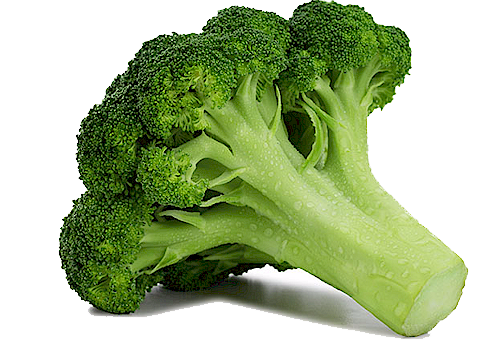Broccoli (Brassica oleracea var. italica) is an edible green plant in the cabbage family (family Brassicaceae, genus Brassica) whose large flowering head, stalk and small associated leaves are eaten as a vegetable. Broccoli is classified in the Italica cultivar group of the species Brassica oleracea. Broccoli has large flower heads, usually dark green, arranged in a tree-like structure branching out from a thick stalk which is usually light green. The mass of flower heads is surrounded by leaves. Broccoli resembles cauliflower, which is a different but closely related cultivar group of the same Brassica species.
It is eaten either raw or cooked. Broccoli is a particularly rich source of vitamin C and vitamin K. Contents of its characteristic sulfur-containing glucosinolate compounds, isothiocyanates and sulforaphane, are diminished by boiling but are better preserved by steaming, microwaving or stir-frying.
Varieties
There are three commonly grown types of broccoli. The most familiar is Calabrese broccoli, often referred to simply as "broccoli", named after Calabria in Italy. It has large (10 -to 20-cm) green heads and thick stalks. It is a cool-season annual crop. Sprouting broccoli (white or purple) has a larger number of heads with many thin stalks. Purple cauliflower or Violet Cauliflower is a type of broccoli grown in Europe and North America. It has a head shaped like cauliflower but consisting of many tiny flower buds. It sometimes, but not always, has a purple cast to the tips of the flower buds. Purple cauliflower may also be white, red, green, or other colors.
Other popular cultivars include Belstar, Blue Wind, Coronado Crown, Destiny, DiCicco, Green Goliath, Green Magic, Purple Sprouting, Romanesco, Sun King and Waltham 29.
Beneforté is a variety of broccoli containing 2–3 times more glucoraphanin and produced by crossing broccoli with a wild Brassica variety, Brassica oleracea var villosa.
Cultivation
The majority of broccoli cultivars are cool-weather crops that do poorly in hot summer weather. Broccoli grows best when exposed to an average daily temperature between 18 and 23 °C (64 and 73 °F). When the cluster of flowers, also referred to as a "head" of broccoli, appear in the center of the plant, the cluster is generally green. Garden pruners or shears are used to cut the head about 25 mm (1 in) from the tip. Broccoli should be harvested before the flowers on the head bloom bright yellow.
Production
In 2019, global production of broccoli (combined for production reports with cauliflowers) was 27 million tonnes, with China and India together accounting for 73% of the world total. Secondary producers, each having about one million tonnes or less annually, were the United States, Spain, and Mexico. In the United States, broccoli is grown year-round in California – which produced 92% of the crop nationally – with 95% of the total crop produced for fresh sales in 2018. Broccoli cannot be harvested using machines, meaning it must be hand-harvested.
Nutrition
A 100 gram reference serving of raw broccoli provides 34 calories and is a rich source (20% or higher of the Daily Value, DV) of vitamin C (107% DV) and vitamin K (97% DV) (table). Raw broccoli also contains moderate amounts (10–19% DV) of several B vitamins and the dietary mineral manganese, whereas other micronutrients are low in content (less than 10% DV). Raw broccoli is 89% water, 7% carbohydrates, 3% protein, and contains negligible fat (table).
Cooking
Boiling substantially reduces the levels of broccoli glucosinolates, while other cooking methods, such as steaming, microwaving, and stir frying, have no significant effect on glucosinolate levels.
Pests
Mostly introduced by accident to North America, Australia and New Zealand, "cabbage worms", the larvae of Pieris rapae, also known as the "small white" butterfly, are a common pest in broccoli. Additional pests common to broccoli production include: Aphids, Cabbage Looper, Cabbage Webworm, Cross-Striped Cabbageworm, Diamondback Moth Caterpillars, Imported Cabbageworm, Cabbage Maggot, Harlequin Bug.
Pictures
Table
| Broccoli | |
|---|---|
 | |
| Species | Brassica oleracea |
| Cultivar group | italica |
| Origin | Italy, more than 2,000 years ago[1][2] |
| Nutritional value per 100 g (3.5 oz) | |
|---|---|
| Energy | 141 kJ (34 kcal) |
6.64 g | |
| Sugars | 1.7 g |
| Dietary fiber | 2.6 g |
0.37 g | |
2.82 g | |
| Vitamins | Quantity %DV† |
| Vitamin A equiv. | 4% 31 μg3% 361 μg1403 μg |
| Thiamine (B1) | 6% 0.071 mg |
| Riboflavin (B2) | 10% 0.117 mg |
| Niacin (B3) | 4% 0.639 mg |
| Pantothenic acid (B5) | 11% 0.573 mg |
| Vitamin B6 | 13% 0.175 mg |
| Folate (B9) | 16% 63 μg |
| Choline | 4% 19 mg |
| Vitamin C | 107% 89.2 mg |
| Vitamin E | 5% 0.78 mg |
| Vitamin K | 97% 101.6 μg |
| Minerals | Quantity %DV† |
| Calcium | 5% 47 mg |
| Iron | 6% 0.73 mg |
| Magnesium | 6% 21 mg |
| Manganese | 10% 0.21 mg |
| Phosphorus | 9% 66 mg |
| Potassium | 7% 316 mg |
| Sodium | 2% 33 mg |
| Zinc | 4% 0.41 mg |
| Other constituents | Quantity |
| Water | 89.3 g |
| |
| †Percentages are roughly approximated using US recommendations for adults. Source: USDA FoodData Central | |


